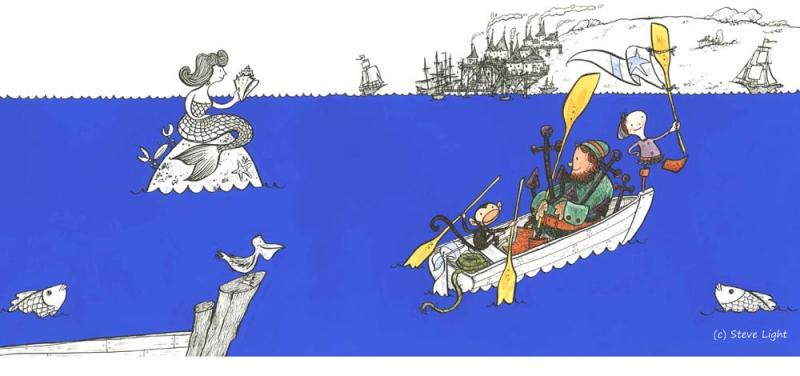"Blue shark, blue shark,
you dip and dive all day.
Pointy snout, bullet nose,
bold eyes that never close,
graceful as the water flows,
bay to bay to bay.
Blue shark, blue shark ... "
If you work with kids in the library or the classroom, or you have children of your own, you will know exactly the ones who are spellbound at the thought of sharks ... and cannot get enough information to suit them. You will always be on the lookout for that new book! You should look no further than Skila Brown's new poetry book about fourteen different sharks, each with its own particular characteristics. As you will see, they are not all the same!
In this exploration of the frightful creatures that lurk in deep waters. Ms. Brown chooses not only the most recognizable of the lot - the great white and the hammerhead - she also includes some that are not so well known to many of us. Each is given a full double page spread to present its most important and telling attributes. I greatly admire the way the text is presented, always in keeping with the character of the shark itself.
For instance, the bull shark:
"Tenacious, aggressive, and stocky,
you ambush your prey at the shore.
You'll eat anything,
button, boat, fin or wing;
you chomp it up, then search for more.
You sneak into freshwater rivers
before your prey finds time to flee.
You give them a bump,
taste a bit of their rump;
you're just an old bull of the sea."
Then she adds a tiny bit of additional detail:
"Bull sharks are unpredictable animals. They head-butt their prey before taking a
bite of them and can even tolerate freshwater, sometimes swimming into rivers!"
Shark aficionados are going to gobble it up, you know they are!
Bob Kolar's digital images accurately and menacingly show those creatures who strike fear in the hearts of many, and admiration and interest in so many others. Muted shades of green, blue, brown and grey place us in the water with them, as light plays all around them and from many angles.
"Pax had been confused by this fear - the small woman was projecting nothing but kindness and concern. She kept repeating the word Pax had already come to associate with his boy -"Peter' - in a pleading tone. The man's full-teeth welcome smile remained frozen in place, but the room had flooded with the bitter scent of deception as he answered her."
Two voices, clearly shared in alternating chapters, give Sara Pennypacker's novel an immediacy that is sure to help this book find its way into the hearts of many middle grade readers. Once started, I didn't put it down until I was hugging it tightly and wanting to start the reading all over again.
The opening is heartbreaking:
"And sure enough, the boy held the toy soldier aloft and then hurled it into the woods. The fox's relief - they were only here to play the game! - made him careless. He streaked towards the woods without looking back at his humans. If he had, he would have seen the boy wrench away from his father and cross his arms over his face, and he would have returned. Whatever his boy needed - protection, distraction, affection - he would have offered."
It is a powerful story about a fox (Pax) and his rescuer (Perer). Theirs are the voices we hear so clearly in this beautifully written tale of friendship and unconditional love. We have met foxes in many other stories, including others this year. Pax will be long remembered, as are so many others ... smart, loyal and knowing. Reeling from the death of his mother five years ago and in need of companionship, Peter found Pax in the cold and takes pity on his plight. Pax is raised with love as a pet. When Peter's father realizes that war is imminent and with it, inherent danger for his son, he decides that Pax will be returned to the wild while Peter will go to live with his grandfather.
In quick time, not being content to leave Pax alone and feeling tremendous guilt for abandoning him, Peter sets out on a sometimes harrowing journey to find his beloved companion again. As we travel the endless miles with Peter, we are also aware through Pax's voice of the trust and love the fox has for the boy while he acclimates to a wild he has never known. We are sure they will find each other. It is not an easy journey.
It is a tale of survival, friendship, violence, death and redemption. Pax and Peter encounter helpful characters who make their world a very different place. Peter's meeting Vola is opportune and life-changing. The ending is poignant, yet hopeful ... and perfect!















































